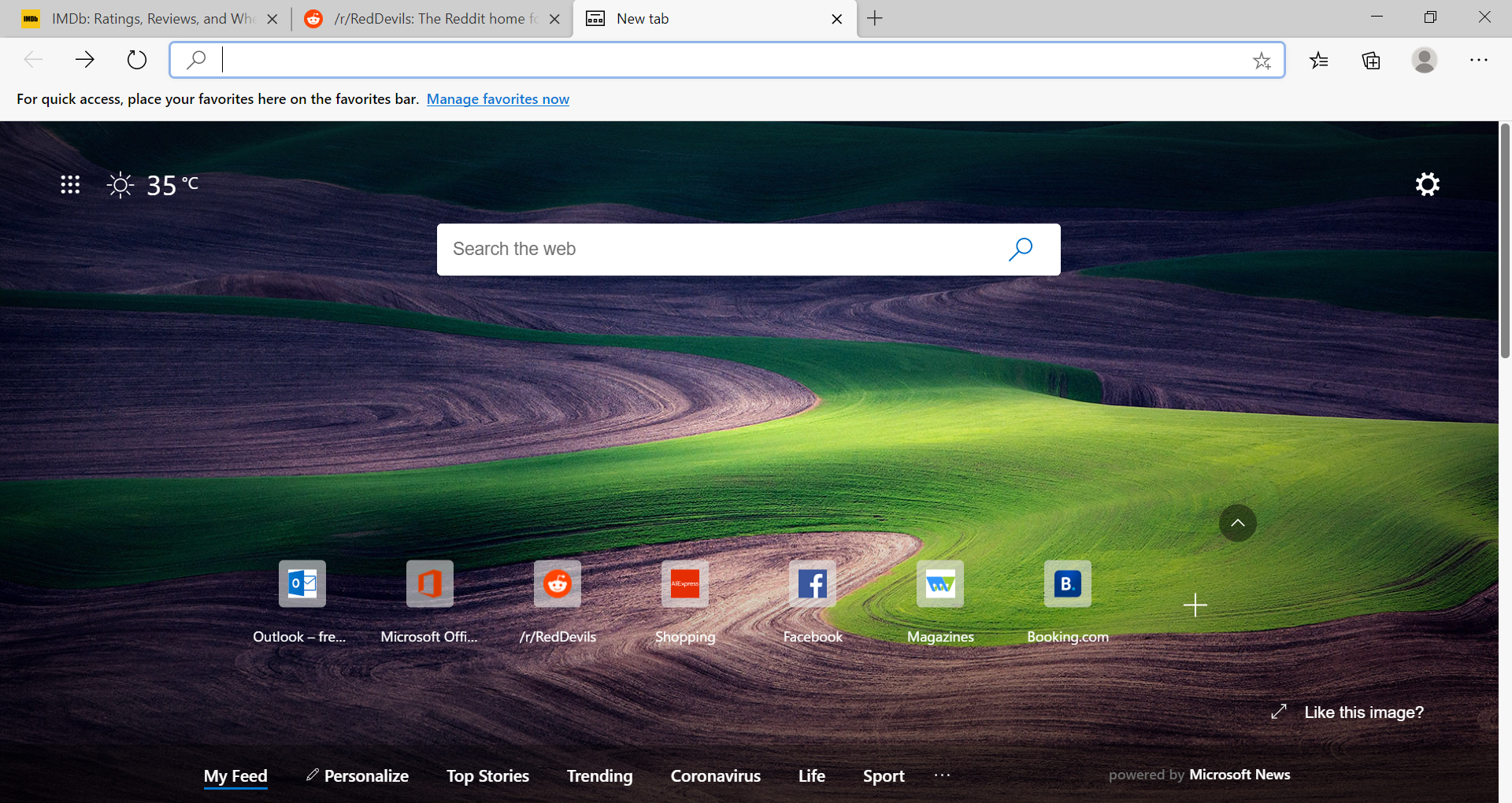And here are the 12 best Microsoft Edge Extensions for doing just that. Before we go into that, we need to show you how to install them though. How to Install Microsft Edge Extensions. To install Microsft Edge extensions, you first need to download the new Microsoft Edge based on Chromium. When you do that, all the Chrome extensions will work. Jan 30, 2020 The new Edge isn't entirely—or even mostly, so far—a Microsoft effort, though. Edge is now based on the open source Chromium browser, which is the underpinning of Google Chrome and several. You can ask about Microsoft Edge's past, present, and future in a Reddit AMA. What you need to know The Microsoft Edge team is holding an AMA on Reddit today. The AMA runs from 11 am-1 pm ET.
The old Microsoft Edge was a completely in-house Microsoft design, proprietary from the ground up. It wasn't necessarily a bad browser, but it never really took off—by the time Edge became a thing, most of the people who cared about their browsers were so sick and tired of Internet Explorer they'd long since moved on to either Firefox or Chrome; and the people who didn't care much about their browsers frequently ended up finding the old Internet Explorer and setting it as their default when they discovered that 'the big blue E' on their taskbar didn't work with legacy IE-only websites and apps.
The new Edge isn't entirely—or even mostly, so far—a Microsoft effort, though. Edge is now based on the open source Chromium browser, which is the underpinning of Google Chrome and several other, lesser-known browsers as well. It should seem immediately familiar to seasoned Chrome users—and it even allows installing extensions directly from Chrome's own Web store. It's not hard to imagine a lot of Chrome users simply not bothering to replace it when they see how familiar it is.
Edge's own Web store is pretty sad and underpopulated right now, but we expect that to change rapidly. It's not hard to imagine little need for an Edge user to bother going to Chrome's Web store and shopping for extensions in another six months, as necessary as that would likely be right now. In the meantime, while installing Chrome certainly isn't hard to do—unless you're seriously short on bandwidth, which many rural users are—it's even easier to click the single popped-up button in Chrome's Web store to enable those extensions in Edge.
AdvertisementSaved passwords
For better or for worse, the vast majority of the new Edge doesn't need much of a review, since it's effectively the same as Chrome itself. The only parts that really need a review are those that Microsoft has needed to bolt on for itself—such as user login and synchronization of saved credentials between browsers. We tested the login and sync, and they were something of a crapshoot.
The first credentials we used to test were Office 365 credentials from a small business, and while the login itself worked immediately, the actual synchronization was broken. To be fair, the problem could be that this Office 365 account doesn't have a license associated with it—it's just used to administer the actual users of a small business's domain. Still, it should have worked; unlicensed Office 365 accounts are a commonly encountered and perfectly valid condition in the wild for exactly this reason.

With the Office 365 account logged in, local storage of passwords worked perfectly, but sync just didn't happen. Eventually, we checked the sync settings for the account and saw that they said 'setting up sync—you can start browsing while we get this set up.' A week later, the settings still say 'setting up sync.' We're not holding our breath.
Next, we used a personal Windows Live account which long predates Office 365 and has been used solely to log in to a Microsoft Volume License Service Center account until now. The personal account immediately worked flawlessly, both login and sync. When logged in with the personal account, there was no 'setting up sync' message—and a newly saved password was instantly available on a second computer logged in with the same account.
Saving credit and debit cards
Edgium—that's what some industry watchers have been calling the new version of Edge—can autofill credit card details, but doing so works differently than it does in Chrome. If you type a credit card number into a Web form, Google Chrome automatically detects what you're doing and asks if you want to save it. Edgium, on the other hand, pays no attention to you typing credit card information to a website. To get the browser to save a credit card number, you must go into its Settings and to Profiles / Payment info.
AdvertisementOnce you've gotten to the Payment info settings dialog, you can click an 'Add card' button. Edge does correctly detect credit card entry, and when you have one or more saved cards available, it will prompt you when there's an opportunity to auto-fill with it. The saved credit card info is, for now at least, purely local—it does not sync from one browser to another when you're logged in as the same user.
Favorites
The one place we outright prefer the new Edge to Google Chrome is in its Favorites management. In both Chrome and Edge, there's a little star inside the address bar itself to toggle Favorite status for a page. But in Edge, there's also a little star button beside the bar, which drops down the list of Favorites you've already created. We're fiercely protective of vertical screen real estate and therefore don't really like enabling the Favorites bar in any browser. But the convenient little drop-down is nice, and we think it makes the Favorites function much more useful.
Favorites synced perfectly and instantly from machine to machine when we tested using our sync-is-working personal Windows Live login.
Microsoft contributions
One of the complaints we've frequently heard from readers about rebasing Edge on the Chromium project is that it removes diversity from the Web browser ecosystem. This is obviously true—if Microsoft uses Chromium to build Edge, it doesn't have to build and maintain the majority of the codebase itself. But it overlooks the strength of open source software development—active cooperation.
Microsoft began contributing code to the Chromium project almost immediately after beginning its first beta builds of Chromium-based Edge. One of its first contributions was to improve battery life in the browser; that contribution is still in development and has not yet been accepted into the Chromium master—but importantly, engineers from Google and Microsoft are cooperating in the testing and implementation here, with a public record for all to see.

Microsoft has also announced its intent to bring browser accessibility, touch optimization, and Arm optimizations from its original Edge into the Chromium project. As CNET reported earlier this week, Microsoft has made nearly 2,000 commits to the Chromium project in the last year. This is an important distinction—the company isn't merely consuming Chromium, it's publicly and openly cooperating with Google in ways that any company or even individual can.
Although Microsoft and Google's collaboration on a unified browser framework does mean less code diversity for the Web, it represents a major improvement in openness and fair access.
Listing image by Mike Mozart / Flickr
As of Wednesday, January 15, Microsoft will make the non-beta version of its new, Chromium-based version of the Edge browser to Windows 10 Home and Pro users. We covered the beta version of Chromium-based Edge in November. The beta was still pretty raw then—but 'raw' is a relative term. The new Edge project began with a complete and fully functional Web browser—Chromium—so it worked fine for browsing the Web. There were just a few rough edges as far as installing extensions, logging into them, and the like.We've seen one take waxing nostalgic for the old, purely Microsoft developed version of Edge, but we don't think many people will miss it much. It's not so much that Edge was a bad browser, per se—it just didn't serve much of a purpose. Edge didn't have the breadth of extensions or the user-base enthusiasm of Chrome or Firefox—and it was no better than they are at running crusty old 'Internet Explorer Only' websites and Web apps.
While there is some validity to worrying about one company 'controlling the Web' and one of Google's biggest competitors now becoming a Google downstream, we don't think those concerns add up to much. We don't want to see the full-on Google Chrome become any more indispensable than it already is—but we don't think Microsoft trading in its own fully proprietary, closed-source HTML-rendering engine for one of the two biggest open source rendering engines is a bad thing.
We downloaded the final beta version of Chromium-based Edge—the one available on the afternoon of the 14th, one day before the official launch—and took it for a spin in a Windows 10 virtual machine. Mostly, it still just looks like a slightly plainer version of Chrome—which isn't a bad thing! Sites load snappily, UI elements are familiar, and so forth. One of the biggest obvious improvements since the last time we test-drove Chromium Edge is the ability to install extensions from the official Chrome Web store.
Advertisement
Microsoft's own Web store is still extremely sparse—we went looking for the must-have, EFF-developed HTTPS Everywhere, and instead we got a recommendation for 'NBC Sports'—which does not seem well-loved by its users. However, typing 'chrome Web store' in the address/search bar took us right where we needed to go and presented us with an obvious tool-tip for installing third-party extensions. That was that—HTTPS Everywhere installed with a single click, just as you'd expect it to on Chromium or Google Chrome itself.
Chromium-based Edge is still missing a couple of obvious features to compete with the full Google Chrome experience—most notably, browser history and extensions don't sync between devices yet. This is described as a temporary problem in the 'Known Issues' page, and it may even be fixed already in the production version launching today.
Pushing the new Edge as something to look forward to right now is difficult—we suspect most people who really care about their browser will continue using Chrome, Firefox, or whatever less-well-known variant they've found and learned to love. Meanwhile, the people who have actually been actively using Edge likely won't notice much of a change—unless Microsoft bobbles something in the user data import functionality when they push the official, non-beta version out through Windows Update later this month.
In all likelihood, the change absolutely will improve the lives of the folks who 'just click the blue E' in the long run, though. It will likely make it easier for Microsoft to lure more technical users—who demand feature and extension parity but might be interested in Edge's Azure authentication back-end—away from Google Chrome.
Microsoft Edge Reviews 2020 Reddit

Chrome Vs Microsoft Edge Reddit 2020
This article initially stated that Chromium-based Edge was being pushed over Windows Update beginning on the 15th; a Microsoft representative reached out to correct us: it was only available for download beginning on the 15th, and will not be pushed over Windows Update until later this month. The article has been updated accordingly.
